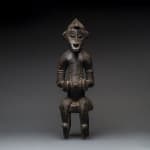Senufo Sculpture of a Seated Male, 20th Century CE
Wood
50.8 x 15.9 cm
20 x 6 1/4 in
20 x 6 1/4 in
PF.5909
Further images
The great revelation of modern art was the active absorption by Western artist of “primitive” African art. Much like Japanese art influenced the Impressionist, African art changed the way artist...
The great revelation of modern art was the active absorption by Western artist of “primitive” African art. Much like Japanese art influenced the Impressionist, African art changed the way artist approached the subject. African art did not imitate natural forms, as in the West, but instead invoked the essence of the subject matter through a complex arrangement of forms, of positive and negative space. Of all the tribal arts that influenced the pioneering Braque and Picasso, the Senufo rank among the most important and influential. Little of this sculpture is realistic, proportions are exaggerated, details omitted; yet it is unequivocally human. The artist, by freeing himself from the constraints of naturalism, producing a work of art that conjures a feeling, a sensation of a human being that is perhaps more real than a photograph of our reflection in a mirror. The sculptor has created a man enthroned upon a stool. In tribal tradition, the stool is the penultimate symbol of authority. This man is most likely a king or at least a tribal leader. His facial features utilizes the aesthetic language of the Senufo including the pointed chin and pursed lips, the nasal structure, the almond-shaped eyes, and the decorative body scarification. In the Western tradition, facial structure identifies the distinct individuality of a person. However, in African art, the facial structure is the result of a strictly maintained artistic tradition that relates the figure to other ancestor sculptures and places the work within the Senufo artistic heritage. Instead, the artist uses the intricate patterns of scarifications to suggest the figure’s personal identity. In this example, the fabulous grid motif carved onto the back of the figure again suggests his high ranking status among the tribe due to the beauty of his elaborate scars. Although this sculpture probably represents a specific ruler among the Senufo, the artist is more concerned with representing the abstract idea of authority and than a specific individual. This masterpiece of African art awes us with its unique interpretation of the human form and allows us to rediscover our own being in a newfound light.







